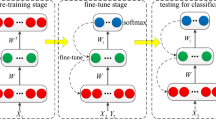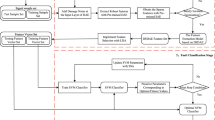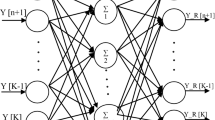Abstract
Fault diagnosis of analog circuits is a classical problem, and its difficulty lies in the similarity between fault features. To address the issue, an end-to-end mutually exclusive autoencoder (EEMEAE) fault diagnosis method for analog circuits is proposed. In order to make full use of the advantages of Fourier transform(FT) and wavelet packet transform(WPT) for extracting signal features, the original signals processed by FT and WPT are fed into two autoencoders respectively. The hidden layers of the autoencoders are mutually exclusive by Euclidean distance restriction. And the reconstruction layer is replaced by a softmax layer and 1-norm combined with cross-entropy that can effectively enhance the discriminability of features. Finally, the learning rate is adjusted adaptively by the difference of loss function to further improve the convergence speed and diagnostic performance of the model. The proposed method is verified by the simulation circuit and actual circuit and the experimental results illustrate that it is effective.

















Similar content being viewed by others
Availability of Data and Materials
The processed data and material required to reproduce these findings cannot be shared at this time as the data also fo-rm part of an ongoing study.
Code Availability
Not applicable.
References
Arabi N, Bourouba A. Belaout, Ayad M (2019) An accurate classifier based on adaptive neuro-fuzzy and features selection techniques for fault classification in analog circuits. Integration 64:50–59. https://doi.org/10.1016/j.vlsi.2018.08.001
Fang F, Li L, Gu Y et al (2020) A novel hybrid approach for crack detection. Pattern Recogn 107:107474. https://doi.org/10.1016/j.patcog.2020.107474
Gao T (2021) A novel fault diagnosis method for analog circuits with noise immunity and generalization ability. Neural Comput Appl 33:10537–11055. https://doi.org/10.1007/s00521-021-05810-4
Haidong S, Hongkai J, Ke Z, Dongdong W, **ngqiu L (2018) A novel tracking deep wavelet autoencoder method for intelligent fault diagnosis of electric locom-otive bearings. Mech Syst Signal Process 110:193–209. https://doi.org/10.1016/j.ymssp.2018.03.011
He W, He Y, Li B, Zhang C (2020) A Naive-Bayes-Based Fault Diagnosis Approach for Analog Circuit by Using Image-Oriented Feature Extraction and Selection Technique. IEEE Access 8:5065–5079. https://doi.org/10.1109/ACCESS.2018.2888950
Li F, Long Z, He P, Feng P (2020) Fully convolutional Pyramidal networks for semant-ic segmentation. IEEE Access 8:229132–229140. https://doi.org/10.1109/ACCES-S.2020.3045280
Li Y, Wang L, Jiang L (2020) ‘Rolling bearing fault diagnosis based on DBN algorithm improved with PSO.’ J Vibration and Shock 39(5):89–96. https://doi.org/10.13465/j.cnki.jvs.2020.05.012
Liu Z, Jia Z, Vong C-M, Han J (2017) Capturing High-Discriminative Fault F-eatures for Electronics-Rich Analog System via Deep Learning. IEEE Trans Industr Inform 13(3):1213–1226. https://doi.org/10.1109/TII.2017.2690940
Mishra PK, Yadav A, Pazoki M (2018) A novel fault classification scheme f-or series capacitor compensated transmission line based on bagged tree ensemble classifier. IEEE Access 6:27373–27382. https://doi.org/10.1109/ACCESS.2018.2836401
Riera-Guasp M, Pineda-Sanchez M, Perez-Cruz J, Puche-Panadero R, Roger-Folch J, Antonino-Daviu JA (2012) Diagnosis of induction motor faults via Gabor analysis of the current in transient regime. IEEE Trans Instrum Meas 61(6):1583–1596. https://doi.org/10.1109/TIM.2012.2186650
Song P, He Y, Cui W (2016) Statistical property feature extraction based on FRFT for fault diagnosis of analog circuits. Analog Integr Circ Sig Process 87(3):427–436. https://doi.org/10.1007/s10470-016-0721-5
Srimani S, Ghosh K, Rahaman H (2020) Wavelet Transform based fault diagnosis in analog circuits with SVM classifier. In 2020 IEEE International Test Conference India (pp. 1–10)
Su X, Cao C, Zeng X, Feng Z, Wu Z (2021) Application of dbn and gwo-svm in analog circuit fault diagnosis. Sci Rep 11(1):7969. https://doi.org/10.1038/s41598-021-86916-6
Tang S, Li Z, Chen L (2015) Fault detection in analog and mixed-signal circuits by using Hilbert-Huang transform and coherence analysis. Micro Electron J 46(10):893–899. https://doi.org/10.1016/j.mejo.2015.07.004
Vasan Sai Sarathi, Long B, Pecht M (2013) Diagnostics and Prognostics Meth-od for Analog Electronic Circuits. IEEE Trans Ind Electron 60(11):5277–5291. https://doi.org/10.1109/TIE.2012.2224074
Wang L (2021) Soft fault diagnosis of analog circuits based on semi-supervised support vector machine. Analog Integrated Circuits and Signal Processing 228–228. https://doi.org/10.1007/s10470-021-01851-w
Wang L, Zhou D, Tian H, Zhang H, Zhang W (2019) Parametric Fault Diagn-osis of Analog Circuits Based on a Semi-Supervised Algorithm. Analog Integr Circ Sig Process 98:517–526. https://doi.org/10.3390/sym11020228
**ao Y (2012) A novel linear ridgelet network approach for analog fault diagnosis usi-ng wavelet-based fractal analysis and kernel PCA as preprocessors. Measurement 45(3):297–310. https://doi.org/10.1016/j.measurement.2011.11.018
Yang H, Meng C, Wang C (2020) Data-Driven Feature Extraction for Analog Ci-rcuit Fault Diagnosis Using 1-D Convolutional Neural Network. IEEE Access 8:18305–18315. https://doi.org/10.1109/ACCESS.2020.2968744
Yang Y, Wang L, Chen H, Wang C (2021) An end-to-end denoising autoencoder-based deep neural network approach for fault diagnosis of analog circuit. Analog Integr Circ Sig Process 107(3):605–616. https://doi.org/10.1007/s10470-021-01835-w
Yong D, Ning L (2017) Soft fault diagnosis in analog circuits based on bispectral models. J Electron Test 33:543–557. https://doi.org/10.1007/s10836-017-5686-5
Yuan Z et al (2018) An efficient feature extraction approachbased on manifold lea-rning for analogue circuits fault diagnosis. Analog Integr Circ Sig Process 102:237–252. https://doi.org/10.1007/s10470-018-1377-0
Zhang C, He Y, Du B (2019) Analog circuit incipient fault diagnosis method based on DBN feature extraction. Chin J Scientific Instrument 40:112–119. https://doi.org/10.19650/j.cnki.cjsi.J1905283
Zhang C, He Y, Yuan L, **ang S (2018) Analog Circuit Incipient Fault Diagnosis Method Using DBN Based Features Extraction. IEEE Access 6:23053–23064. https://doi.org/10.1109/ACCESS.2018.2823765
Zhang T (2019) A novel approach of analog circuit fault diagnosis utilizing RFT noise estimation. Analog Integr Circuits Signal Process 98:517–526. https://doi.org/10.1007/s10470-018-1351-x
Zhao G, Liu X, Zhang B, Liu Y, Niu G, Hu C (2018) A novel approach for analog circuit fault diagnosis based on Deep Belief Network. Measurement 121:170–178. https://doi.org/10.1016/j.measurement.2018.02.044
Funding
This work is supported by the National Natural Science Foundation of China [No.61661013] and Innovation Project of GUET Graduate Education [2021YCXS132 and YCSW2022281]. (Corresponding author: Chunquan Li).
Author information
Authors and Affiliations
Contributions
All authors contributed to the study conception and design.
Corresponding author
Ethics declarations
Ethics Approval
Not applicable.
Consent to Participate
All authors approved the version to be published and agree to be accountable for all aspects of the work in ensuring that questions related to the accuracy or integrity of any part of the work are appropriately investigated and resolved.
Consent for Publication
All authors approved the final manuscript and the s-ubmission to this journal.
Conflict of Interest
The authors declare that there is no conflict of interest or competing interest.
Additional information
Responsible Editor: B. C. Kim
Publisher's Note
Springer Nature remains neutral with regard to jurisdictional claims in published maps and institutional affiliations.
Rights and permissions
Springer Nature or its licensor (e.g. a society or other partner) holds exclusive rights to this article under a publishing agreement with the author(s) or other rightsholder(s); author self-archiving of the accepted manuscript version of this article is solely governed by the terms of such publishing agreement and applicable law.
About this article
Cite this article
Shang, Y., Wei, S., Li, C. et al. An End-to-End Mutually Exclusive Autoencoder Method for Analog Circuit Fault Diagnosis. J Electron Test 40, 5–18 (2024). https://doi.org/10.1007/s10836-023-06097-0
Received:
Accepted:
Published:
Issue Date:
DOI: https://doi.org/10.1007/s10836-023-06097-0




